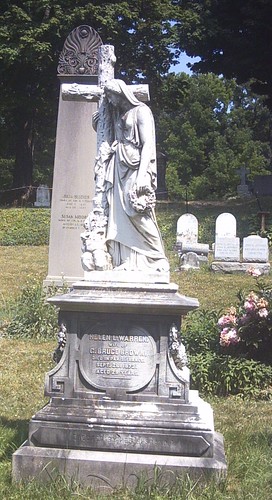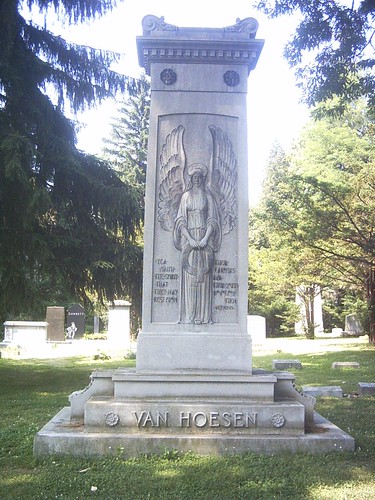In spite of the region’s currently dismal outlook, western New York and especially the area around Rochester hold riches in history. Of American religious history there are few places more significant: just down the road is Palmyra, where Joseph Smith at his farm received the golden plates from Moroni. There every year the Mormons put on the extravagant Hill Cumorah pageant. (We visited the Smith farm several years ago; we didn’t return this time.) Smith’s beginnings were part of a larger spirit of radicalism in region, which thanks to the fact that Susan B. Anthony called Rochester home, was in the nineteenth century a center for the abolitionist and suffragist movements. The city is also home to the first municipal cemetery in the U.S., Mt. Hope Cemtery, where Anthony, Frederick Douglass, and many, many others are buried. We wandered the cemetery widely and still saw very little. The monument sculptures are often conventional—angels carrying crosses or anchors or roses, funerary urns, and so forth—but still beautiful.
One of the more famous persons buried at Mt. Hope is the founder of the Gannett newspaper empire, Frank Gannett. His monument is one of the more startling, not only because of the black marble, but also because of the creepy newspaper boy etched upon it.
Clarissa Hyde’s marker is one of my favorites in large part because the story engraved on the stone isn’t hers, but her father’s. “Clarissa Hyde,” it reads,
Wife of Josiah L. Patterson
born at Lebanon, Conn.
Apr. 17, 1787
Died at Parma, N.Y., Apr. 16, 1837
She was the daughter of
Gen. Caleb Hyde
Who took an active part in the
Revolution was sheriff of
Berkshire Co., Mass. and imprisoned
The rebels taken at the battle
Of Great Barrington in the
Shay Rebellion. He afterwards
Removed to Broome Co. N.Y.
Was a Major General State
Senator and member of the
Council of Appointment
Below is Susan B. Anthony’s gravestone; beside her, her sister Mary. On the four faces of the family marker are four virtues: “Humanity,” “Liberty,” “Equality,” and “Justice.” They’re bold virtues to claim for a family. Fortunately, the Anthonys lived up to them. In the background you can see how the grass in the cemetery was parched. According to Kathy’s mother, they haven’t had much rain this year. Also, does anyone know what the pebbles are for?
And finally, Frederick Douglass, who has a substantial spread. Both of his wives are buried with him.








Yikes! That Gannet stone is creepy and tacky.
I love wandering around in old cemeteries. Even not so old ones. It’s surprising how much you can piece together about a family sometimes just based on their burials. B thinks I’m weird, but I consider it the living’s duty to the dead to go out of the way every now and then to think about them.
by JH—Jun 26, 10:06 AM
You mean to say that you actually do have a sense of propriety? Amazing! You never cease to surprise me, JH.
I’m more prone to visit cemeteries than I used to be. I’m not sentimental about the dead, not even those to whom I’m kin. But I do appreciate the stories the dead tell about themselves, or in the case of Clarissa Hyde, about somebody else. I expect that her father’s grave has much the same story. Also in the cemetery (I didn’t put the image online) is a man whose grave marker makes clear that he was Buffalo Bill’s adopted son: Bill’s shadow looms, even in death. It fascinates me that people take any way they can to make their own fame sufficient, even if it means writing themselves completely out of their own lives.
by greg—Jun 26, 10:15 AM
Once I saw a small family plot in a little church yard in a rural enclave near Oxford. All three sons died in WWI, in the same battle. The father died the next year. The mother lived on for 15 more years.
The grim austerity with which these facts are disclosed somehow makes it even easier to imagine this tragedy, which wiped out an entire family with one fell swoop, leaving behind one old woman to survive them for years and years. What I can’t imagine is how she managed to carry on.
by JH—Jun 26, 10:27 AM
An elderly woman whom I know here, an acquaintance, went through something similar. Her husband disappeared in Korea; his body was never recovered. The family spent years hoping any news would surface, but it never did. She never remarried, as I remember, and I gather that much of her life has been lived with no small amount of sadness. Not without joy, mind, but out of sorts with it.
Unrelated but nevertheless true: she’s also a great-niece of Walt Whitman.
by greg—Jun 26, 02:37 PM